American Golden Plover - 2017
 Sunday, April 19, 2020 at 2:14PM
Sunday, April 19, 2020 at 2:14PM  Pembrokeshire Avifauna committee | Comments Off |
Pembrokeshire Avifauna committee | Comments Off |  Wader,
Wader,  vagrant in
vagrant in  American Golden Plover
American Golden Plover  Sunday, April 19, 2020 at 2:14PM
Sunday, April 19, 2020 at 2:14PM  Wader,
Wader,  vagrant in
vagrant in  American Golden Plover
American Golden Plover  Tuesday, April 7, 2020 at 9:55AM
Tuesday, April 7, 2020 at 9:55AM One at the Gann, 11 August 1950. (Barrett, 1959)
 Rarity,
Rarity,  Wader in
Wader in  Pectoral Sandpiper
Pectoral Sandpiper  Tuesday, March 31, 2020 at 9:12AM
Tuesday, March 31, 2020 at 9:12AM 
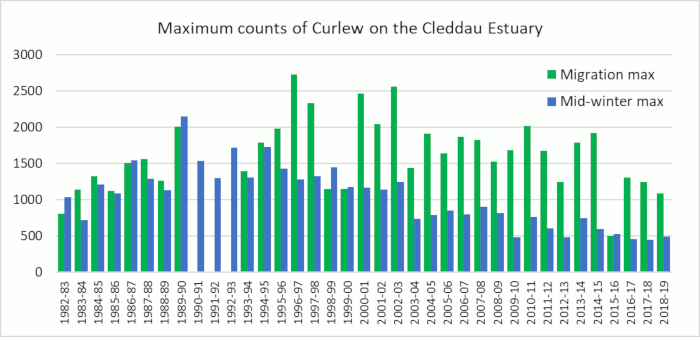

 Monday, March 30, 2020 at 8:27AM
Monday, March 30, 2020 at 8:27AM Two at the Gann from 13-16 September. This is the only Welsh record of more than a single bird.
 Wader,
Wader,  vagrant in
vagrant in  Baird's Sandpiper
Baird's Sandpiper  Tuesday, February 25, 2020 at 3:40PM
Tuesday, February 25, 2020 at 3:40PM Vagrant - no previous island records
A vocal juvenile which circled North Plain in heavy drizzle on the evening of 20th September was seen and heard sufficiently well to confirm the identification before it roosted on the back of North Pond 50 (RDB, GE, BB, et al.). The bird was seen in flight and heard several times the following morning, although it did not settle and good views seemed unlikely. However the arrival of a juvenile Dunlin appeared to relax the dowitcher and they fed together during the afternoon of the 21st. It was not seen to leave North Pond for the next three days and generally fed alone from the 22nd. There was no sign of it on the 25th following a calm and clear night.
Phot (c) Richard Brown from Skokholm blog
This was the first record for Skokholm and only the third for Pembrokeshire following first-winter birds at the Gann between 12th December 1987 and 3rd January 1988 and between 1st January and 23rd March 2013 (Rees, 2014).
Skokholm Bird Observatory Annual Report 2015 (Richard Brown & Giselle Eagle)
 Skokholm,
Skokholm,  Wader,
Wader,  vagrant in
vagrant in  Long-billed Dowitcher
Long-billed Dowitcher  Tuesday, February 25, 2020 at 3:37PM
Tuesday, February 25, 2020 at 3:37PM Vagrant - no previous island records
Two summer plumaged birds found on North Pond during 9th June were the first record for Skokholm and the first spring record for Pembrokeshire (SWR, PTI, RDB et al.). They were still present the following day but were not seen on the 11th.
Photos etc on Skokholm blog
The four previous Pembrokeshire records were a first-winter shot on a farm pond near St Twynells in c.1900 (the specimen was confirmed as this species in 1928), singles off St Ann’s Head on 19th September 1950 and at the Gann on 16th September 1957 and most recently a juvenile on a slurry pond at Haroldston West on the 4th and 5th October 1983 (Rees, 2011).
Nationally 2015 was an exceptional year for passage records of this species and it proved a record breeding year in Shetland.
Skokholm Bird Observatory Annual Report 2015 (Richard Brown& Giselle Eagle)
 Skokholm,
Skokholm,  Wader,
Wader,  vagrant in
vagrant in  Red-necked Phalarope
Red-necked Phalarope  Saturday, October 6, 2012 at 11:04PM
Saturday, October 6, 2012 at 11:04PM 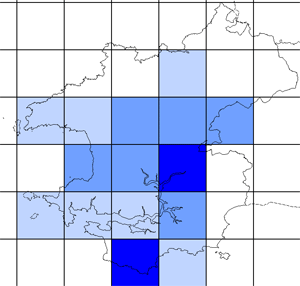 The BTO winter atlas showed that Golden Plovers were present in both estuarine and agricultural 10km squares during the winters of 1981-82, 1982-82 and 1983-84.
The BTO winter atlas showed that Golden Plovers were present in both estuarine and agricultural 10km squares during the winters of 1981-82, 1982-82 and 1983-84.
The darker the colour, the higher the relative total count for each 10km square. The darkest blue represents over 496 birds.
Day roosting birds made up high numbers at the Cleddau Estuary, whereas those on the Castle Martin ranges were active feeders.
Graham Rees
 Thursday, November 24, 2011 at 8:39PM
Thursday, November 24, 2011 at 8:39PM Winter visitor and passage migrant
There is no evidence of any change in status since Mathew (1894) and Lockley et al (1949).
A considerable autumn passage commences in early July and continues into November, with peak movement in September. Some birds pause to feed on the estuaries and to a lesser extent on mainland beaches and offshore islands. They have also been seen passing during the day from ships offshore and from the Smalls and off Strumble Head, as well as being detected moving at night at the lighthouses of the latter two localities. Observations at Stumble head confirm the September peak which is also reflected in counts from the Cleddau, Teifi and Nevern estuaries.
The main winter arrival occurs in November and December and is nocturnal. The principal areas of the Cleddau Estuary used are between Hook and Llangwm, Carew/Cressell Rivers, Llandstadwell, Pembroke River and Angle Bay.
On average about 80 dunlin winter on the Teifi Estuary and 20-30 on the Nevern Estuary. They are scarce and irregular elsewhere.
Departure takes place in March, is rapid and thought to be nocturnal. Ringing has shown that some winter birds arrive via Scandinavia; for example, on ringed on 31 August 1952 at Ottenby in Sweden was recovered at Milford Haven on 10 December.
Small numbers pass through Pembrokeshire from April to mid-June, pausing briefly on the offshore islands, the Gann and the Nevern and Teifi estuaries, with a rapid turnover of individual. They can sometimes be seen departing northwards on calm evenings from places such as Angle Bay and the Gann, when they rise from the flats and circled in tight groups, calling incessantly, sudddinly falling quiet as they set off on a bearing.
Donovan J.W. & Rees G.H (1994), Birds of Pembrokeshire
 Sunday, October 9, 2011 at 5:00PM
Sunday, October 9, 2011 at 5:00PM 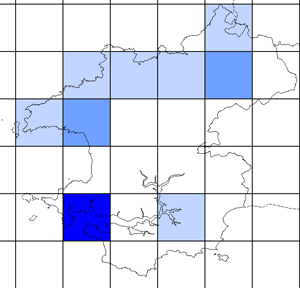
The BTO winter atlas showed that Jack Snipes were present in a third of Pembrokeshire 10km squares during the winters of 1981-82, 1982-82 and 1983-84.
The darker the colour, the higher the relative total count for each 10km square. The darkest blue represents over 4 birds recorded per day.
Probably under recorded as usually not discovered until almost trodden on.
Graham Rees
 Sunday, October 9, 2011 at 12:57PM
Sunday, October 9, 2011 at 12:57PM 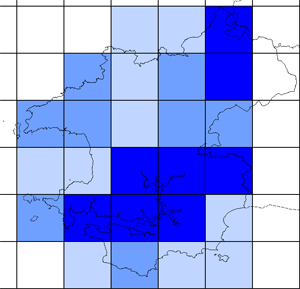
The BTO winter atlas showed that Snipes were present in most 10km squares during the winters of 1981-82, 1982-82 and 1983-84.
The darker the colour, the higher the relative total count for each 10km square. The darkest blue represents over 37 birds, up to 200 were recorded in some squares in the county.
Graham Rees
 Sunday, September 18, 2011 at 4:15PM
Sunday, September 18, 2011 at 4:15PM 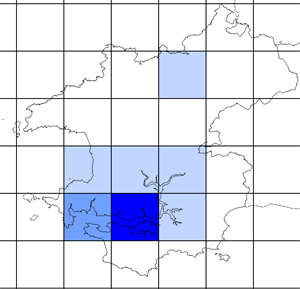
The BTO winter atlas showed that Greenshanks were present in six estuarine 10km squares during the winters of 1981-82, 1982-82 and 1983-84.
The darkest colour represents over 6 birds seen a day. It is likely that the birds concerned were Scottish breeders.
Graham Rees
 Sunday, September 18, 2011 at 4:12PM
Sunday, September 18, 2011 at 4:12PM 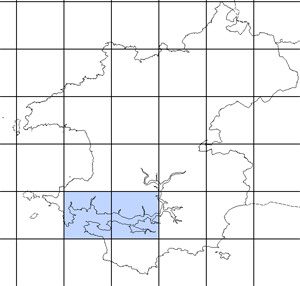
The BTO winter atlas showed that Green Sandpipers were present in two estuarine 10km squares during the winters of 1981-82, 1982-82 and 1983-84.
The colour represents single birds seen a day. The UK is at the northern extremity of the winter range of this species.
Graham Rees